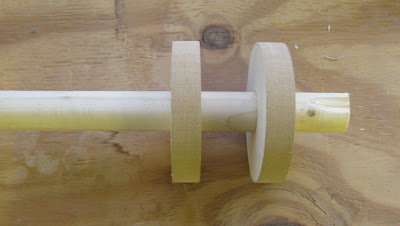-Design some tools which could make the use of the technique easier.-To develop a character that they would make (example of the string dolls: http://kamibashi.com/)
-While there, enrich the research of the Crisis project (see my blog CRISIS).-Could this technique be taught to other people to help them as well?January, 19 2009We just had a meeting with some students of the university, interested in "Design for development". The idea would be to associate our efforts and ideas in this area of design to get more results.What could I do to make the technique with the plastic bottles more user friendly ? The problems: -the bottle necks are extremely difficult to cut -It is difficult to get some stripes of plastic really regular-Would it be possible to find a tool which would permit to cut some rings from the bottles?
January, 23 2009
A tool to cut some rings.The first prototype is just a guide I put into the bottle and which I follow with my knife.
It works quite well, even though it is not really stable. As a consequence, the ring is not very regular.Then, I have tried to modify the tool by putting the blade directly on it to cut from the inside. It works quite well but the problem of stability is even worst..I'm planning to make a took which remains really simple: a thread rod with discs of different diameters (according to the diameter of the bottles).
diameters of the different bottles found in the Supermarket
Shandy Boss (2litters): 31cm
Sainsbury’s sparkling water: 25,7cm
Pepsi (2litters): 31,2 cm
Sainsbury’s classic cola: 30,8cm
Sainsbury’s lemonade:30,8cm
Coca Zero:31,2 cm
Fanta 31,2 cm
Orangina: 30,1cm
Dr Pepper: 31,4cm
Old Jamaïca ginger beer: 27,7cm
Sprite: 31,5cm
7up:31,2 cm
Lilt Pineaple and Grapefruit: 31, 3cm
Sainsbury’s diet pineaple and grapefruit: 30,7cm
Rwhites: 31,2cm
The bottle neck is very thick and therefore a particularly difficult part to cut.
I try to cut it by heating it: it works but the result is not clean.
Finally, I discovered this really nice tool usually used to cut metal tubes.
I will use this tool as it is. I will just have to make some cylinders to put inside the bottle neck while I'm cutting it, in order to prevent it to be flattened with the pressure.
I'm looking for different ways to cut the plastic of the bottles. I heat a piece of metal and cut the plastic with it.
It works quite well but it does not seem to be the easiest solution to use in the camps.
How to cut regular strips of plastic?
I got inspired by a tool usually used in cabinet making to mark points of reference on pieces of wood always at the same distance from the edge.
My trials are not really satisfying.
I finally bought a guillotine which I aim to adapt a bit to respond exactly to my needs.
Cutting two regular lines on a small piece of plastic.































Aucun commentaire:
La publication de nouveaux commentaires n'est pas autorisée.